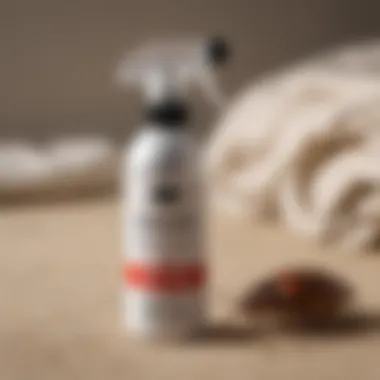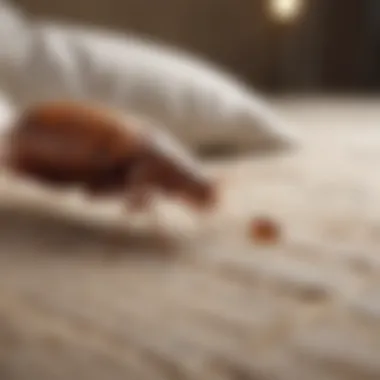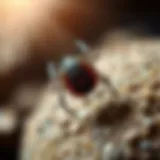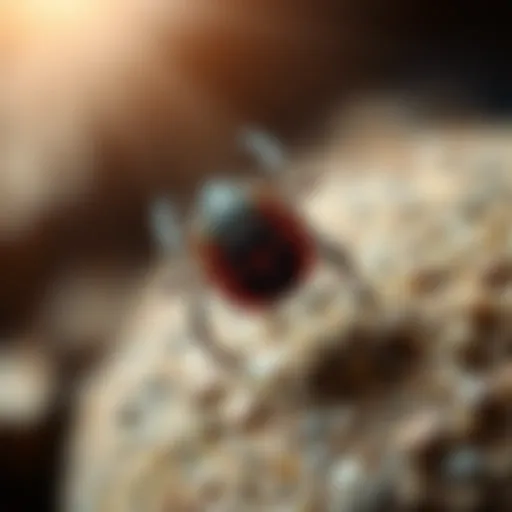Top Bed Bug Sprays: Effective Solutions for Infestations


Intro
Bed bugs have emerged as a significant concern for households across the globe. These tiny pests, often elusive and difficult to detect, can lead to sleepless nights and countless stress. Understanding their behavior, effective control measures, and the right sprays available on the market becomes essential for homeowners. Bed bug sprays come in a variety of formulations and application methods, making knowledge about these options vital in addressing infestations effectively.
By choosing the correct product, one can ensure a safer living environment. In this article, we will examine the best bed bug sprays available, exploring their efficacy and the specific circumstances under which they are most beneficial.
Understanding Pests
Definition of Pests
Pests are defined as organisms that negatively affect human activities or health. In this context, bed bugs are considered pests due to their parasitic nature. They feed on human blood and thrive in environments where they have easy access to their hosts. Understanding the life cycle of these pests can aid in effective management strategies.
Importance of Pest Identification
Identifying bed bugs accurately is crucial for effective control. Misidentification can lead to the use of incorrect treatments, prolonging the infestation. Signs of a bed bug infestation include:
- Small reddish-brown spots on bedding
- Shell casings from molted bed bugs
- Musty odors in infested areas It is vital to know what you face before implementing any treatment plan.
Prevention Techniques
Home and Garden Preventative Measures
Keeping a pest-free home involves comprehensive preventative practices. Here are some actionable steps:
- Seal cracks and crevices in walls and floors to limit hiding spots.
- Wash bedding regularly in hot water to eliminate eggs and bugs.
- Use protective covers for mattresses and box springs to prevent bed bug entry.
Seasonal Prevention Tips
Different seasons can affect pest activity. During warmer months, bed bugs may become more active as people travel. It's advisable to check hotel rooms and luggage for any signs of bed bugs when returning home.
Eco-Friendly Pest Control Solutions
Overview of Sustainable Practices
As consumers grow more environmentally conscious, eco-friendly pest control solutions are becoming increasingly popular. Using products that do not harm the environment provides peace of mind.
Natural Remedies and Their Effectiveness
Several natural remedies claim effectiveness against bed bugs, though results can vary. Options like diatomaceous earth or essential oils like tea tree oil may offer some assistance. However, it is essential to research and identify what remedies may work for your specific situation.
"Knowledge, combined with the right products, is key to effective pest management."
Utilizing a variety of approaches tailored to individual situations allows for more successful control of bed bugs. In the coming sections, we will delve deeper into specific products and methods that empower homeowners in the battle against these pests.
Understanding Bed Bugs
Understanding bed bugs is fundamental to addressing issues related to infestation effectively. Bed bugs, scientifically known as Cimex lectularius, are small, parasitic insects known for their exclusive diet of human blood. Their presence in homes poses not only a nuisance but also significant health concerns. Gaining insight into their biology, behavior, and signs of infestation is essential for timely and effective action against these pests.
Biology and Behavior of Bed Bugs
Bed bugs are small, typically measuring around 4 to 5 millimeters in length. They possess reddish-brown bodies and are flattened, allowing them to hide easily in crevices. Their biology is adapted to a nocturnal lifestyle, enabling them to feed on unsuspecting hosts during the night.
The reproduction cycle of bed bugs is prolific. A female can lay hundreds of eggs in her lifetime, making rapid infestations possible. They are resilient and can survive for several months without a meal. This extended survival capability complicates eradication efforts. Understanding these biological characteristics is crucial in recognizing the potential extent of an infestation and the difficulty in elimination.
Signs of Infestation
Identifying the signs of a bed bug infestation is the first step toward effective treatment. Homeowners may notice the following indicators:
- Bite Marks: Often, people wake up with red, itchy welts that resemble mosquito bites, usually in clusters or lines.
- Blood Stains: Small brown or red blood spots may appear on bedding, mattresses, or upholstery.
- Fecal Matter: Dark spots on sheets or furniture may indicate bed bug droppings.
- Exoskeletons: As bed bugs grow, they molt, leaving behind empty exoskeletons around hiding places.
- Bed Bug Smell: A sweet, musty odor may develop in heavily-infested areas.
Recognizing these signs early can help prevent the problem from worsening and reduce anxiety associated with these pests.
Health Risks and Implications
The presence of bed bugs can result in various health risks that extend beyond physical discomfort. While bed bugs are not known to transmit diseases, their bites can lead to significant itching and secondary infections if scratched. Psychological impacts are also notable, as residents may experience stress, insomnia, and anxiety due to the worry of infestation.
The social stigma associated with bed bugs can affect one’s personal and occupational interactions. The embarrassment that often accompanies an infestation can deter individuals from seeking necessary help. Therefore, addressing health implications associated with bed bugs is not merely about eradicating pests but also involves mental well-being and social interactions.
According to the CDC, "the presence of bed bugs in one's home can lead to significant distress and anxiety."


In summary, comprehending the full scope of bed bugs, from their biology to the potential ramifications of an infestation, equips homeowners and housewives with the knowledge needed to combat these pests adequately. A proactive approach is essential in preventing small issues from escalating into larger, more troublesome infestations.
The Necessity for Effective Treatment
Effective treatment of bed bug infestations is essential for maintaining a safe and comfortable living environment. Bed bugs are notorious for their resilience, and dealing with them requires careful consideration of various treatment options. An effective approach not only ensures the elimination of pests but also mitigates potential health risks associated with their presence. Moreover, understanding why conventional methods may fail and the significance of bed bug spray can significantly influence one’s pest management strategy.
Why Conventional Methods May Fail
Traditional methods for dealing with bed bugs often revolve around practices that may not address the core problem. Methods such as vacuuming and washing fabrics can help reduce the population temporarily but do not eliminate these pests completely. Bed bugs have an innate ability to hide in microscopic crevices and can survive prolonged periods without feeding. With that said, the limitations of conventional methods can be highlighted through the following points:
- Limited Reach: Conventional techniques seldom penetrate deep into furniture or wall crevices where bed bugs often reside.
- Repopulation Risk: If any bed bugs survive treatment, they can quickly repopulate, leading to recurring infestations.
- Misidentification: People sometimes confuse bed bug bites with those of other pests, leading to ineffective countermeasures.
For effective long-term management, utilizing targeted treatments like bed bug sprays is highly necessary. These products are formulated to penetrate and eliminate bed bugs at all life stages, providing a more thorough solution.
The Role of Bed Bug Spray
Bed bug spray occupies a vital role in the ongoing battle against these pests. Their primary function is to deliver a direct and impactful solution to infestations while being tailored to the unique behaviors and biology of bed bugs. Here are key factors that underline the importance of bed bug sprays:
- Targeted Action: Bed bug sprays are designed specifically to combat these pests and can effectively kill on contact or through residual action, ensuring they remain effective for an extended period.
- Variety of Formulations: The market offers a range of options, including chemical-based and eco-friendly sprays, allowing homeowners to choose products that meet their safety and environmental preferences.
- Accessibility and Ease of Use: Many bed bug sprays are convenient and can be applied without professional assistance, enabling homeowners to quickly tackle an infestation, which is ideal for urgent situations.
"The right spray can significantly reduce bed bug populations and provide immediate results, making it an indispensable part of any pest management strategy."
In summary, recognizing the limitations of traditional methods and understanding the strategic role that bed bug sprays play can be a game-changer when dealing with infestations. Without an effective treatment plan, homeowners may find themselves in a seemingly endless cycle of bed bug problems, risking both comfort and health.
Criteria for Selecting Bed Bug Sprays
Choosing the right bed bug spray is critical for effective pest management. It is not just about picking any product from the shelf. Understanding specific criteria can make significant difference in how well you tackle an infestation. The right criteria help you navigate the multitude of options available. It ensures you choose a product that is effective, safe, and suitable for your situation.
Understanding Active Ingredients
Selecting a bed bug spray often comes down to knowing what is in the product. Two main categories of active ingredients are key: pesticides and organic alternatives. Recognizing the differences can guide a more informed decision.
Pesticides
Pesticides are chemical compounds specifically designed to eliminate pests. They often contain synthetic ingredients that target the nervous system of insects. A key characteristic of pesticides is their fast-acting nature. This can lead to quick results, which many find attractive when faced with an infestation.
However, their unique feature lies in the potential health risks they pose. While they are effective, pesticides can cause irritation or other side effects for humans. Therefore, it’s essential to follow the instructions carefully and ensure proper ventilation during application.
Organic Alternatives
Organic alternatives generally use natural substances to repel or kill bed bugs. They can be derived from plant extracts or oils, making them a popular choice for those seeking less toxic options. One defining characteristic of organic alternatives is their lower chemical residue, which often appeals to eco-conscious consumers.
Their unique feature lies in their typically safer profile for both humans and pets. However, they may not work as quickly or vigorously as their pesticide counterparts. As such, while they can be effective, severe infestations may require more aggressive treatment methods.
Efficacy and Longevity
When selecting a bed bug spray, efficacy is paramount. A product’s ability to effectively kill pests and residual longevity determines how long protection lasts after application. Stronger formulations may provide lasting effects, while some sprays require frequent reapplication. Understanding this helps in planning the treatment effectively.
Application Techniques
All bed bug sprays are not created equal when it comes to application. Some require special equipment, such as foggers, while others can be applied easily with a spray bottle. Knowing the right technique is fundamental. Proper application helps reach all affected areas, increasing the likelihood of successful pest eradication.
Safety Considerations
Safety is a major consideration when selecting bed bug sprays. The effects on humans and pets should be of high priority.
For Humans
For humans, selecting sprays with safer formulas can prevent irritation or allergic reactions. Products labeled as non-toxic or low in volatile organic compounds (VOCs) are likely more suitable choices. This emphasis on safety not only protects your health but also eases the stress of dealing with pests in your living space.
For Pets
For pets, understanding the safety of the chosen spray is vital. Some chemicals are harsh and potentially harmful if pets are exposed or ingest the product. Using pet-safe alternatives can relieve concerns for pet owners. Always read labels for warnings, and ensure that you take appropriate precautions right after application.
Top Bed Bug Sprays Available
Choosing the correct bed bug spray is crucial for effective pest management. The market offers various options, each with unique formulations and benefits. It is vital to understand the differences between chemical-based and eco-friendly sprays. These products aim to combat infestations that can disrupt peace and well-being in households. Furthermore, understanding the specific elements of each spray helps in making informed decisions based on personal preferences and environmental considerations.
Chemical-Based Options
Chemical-based sprays are commonly used for their potent effectiveness. They often contain insecticides that target bed bugs specifically. However, it is important to use them carefully, considering their potential impacts on humans and pets in the household. Here are two notable products in this category:


Product A Overview
Product A is known for its fast-acting formula. It combines two active ingredients that are effective against bed bugs at various life stages. This product stands out due to its residual effect, allowing it to continue killing bed bugs for weeks after application. Its quick action makes it a popular choice among homeowners facing severe infestations. However, it should be used with caution due to its strong chemical presence, which may be harmful to sensitive individuals.
Product B Overview
Product B offers a unique dual-action approach, managing already existing bed bugs and preventing future infestations. This product is beneficial for its easy application, often coming in convenient spray bottles. Many users appreciate its low odor, making it suitable for indoor use. However, it may have less effectiveness on larger infestations compared to more potent options, which could require multiple applications.
Eco-Friendly Sprays
Eco-friendly sprays are gaining popularity as more people seek safer alternatives. These products often use natural ingredients that pose less risk to health and the environment. Here are two noteworthy options:
Product Overview
Product C harnesses essential oils as its main active ingredient. This characteristic not only makes it effective against bed bugs but also ensures a pleasant scent that appeals to many users. It has received attention for being non-toxic, an advantage for households with children or pets. However, its effectiveness may vary, requiring more frequent applications to maintain control over bed bug populations.
Product Overview
Product D features a biodegradable formula that appeals to eco-conscious consumers. What distinguishes this spray is its ability to eliminate bed bugs and their eggs. Additionally, it is suitable for treating larger areas due to its high coverage capacity. However, as with many eco-friendly options, additional applications may be necessary, particularly in cases of heavy infestation.
"Selecting the right bed bug spray is essential for effective infestation control, considering both effectiveness and safety."
Application and Best Practices
Applying bed bug spray effectively is crucial for determining how well the product will work in eradicating these pests. Understanding how to prepare for application and the recommended techniques can significantly increase the success rate of treating an infestation. Good practices ensure that the spray reaches the bed bugs and their hiding spots, maximizing the effectiveness of the chosen product.
Preparation Prior to Application
Before using any bed bug spray, thorough preparation is essential. Take the time to gather all necessary tools and supplies. Start by removing all items from the areas being treated. This includes bedding, clothing, and personal items. Laundering these items in hot water can eliminate any bed bugs and eggs present.
Next, declutter the room. Remove unnecessary belongings to create a clear path for treatment. Not only does this help expose hiding areas, but it also allows for thorough application of the spray. Pay special attention to corners, cracks, and crevices, as these are common refuges for bed bugs.
Ensure that you also read the label of the bed bug spray thoroughly. Understanding the instructions, safety precautions, and ventilation requirements is vital. Some sprays may require covering furniture or floors to protect them from harm. In addition, check if any pets or people need to be out of the treated area during or after application.
Recommended Application Techniques
The techniques used during the application of bed bug spray are critical. Ensure that you use the spray in conditions that are not excessively windy or humid, as this can reduce its effectiveness. A misting approach often works best, aiming for both surfaces where bed bugs might be present.
- Direct Targeting: Apply the spray directly to areas where bed bugs are suspected. Focus on mattress seams, bed frames, and furniture edges.
- Even Distribution: When spraying surfaces, keep the nozzle approximately 8 to 12 inches away, providing an even coat without saturating. Over-saturating can lead to runoff, decreasing effectiveness and creating a health risk.
- Follow-Up: After treating, mark the areas sprayed and schedule a follow-up inspection. If you still see bed bugs after the initial application, a second treatment may be necessary. Regularly check the areas around beds and furniture, looking for any signs of resurgence.
"Preparation and correct application techniques are key to success in managing bed bug infestations.
Utilizing these practices can save time and ensure a higher success rate with your chosen bed bug spray product."
By preparing properly and employing effective application techniques, homeowners can take charge in the battle against bed bugs. This proactive approach lays the groundwork for effective pest management, leading to a healthier, safer living environment.
Post-Application Considerations
The post-application phase is crucial in addressing bed bug infestations. After choosing and applying a bed bug spray, it is essential to evaluate its effectiveness and be vigilant for any signs of continuing issues. This stage is not merely about waiting to see if the treatment works; it involves active observation and strategic actions to ensure the successful eradication of these pests.
Evaluating Efficacy
To determine if the bed bug spray has been effective, one must conduct a thorough evaluation. This involves several steps:
- Monitor the treated areas: Regularly check for any live bugs, especially in locations previously infested. Pay attention to usual hiding spots like mattresses, bed frames, and baseboards.
- Assess the presence of bites: Take note of any new bites on the skin. This is often a strong indicator of continued activity.
- Use detection tools: Consider using bed bug interceptors or traps that can help monitor the situation over time. These devices can effectively capture bed bugs that attempt to cross them.
Looking for these indicators will help confirm if the initial treatment was successful. If bugs remain, further action might be necessary.
Signs of Continuing Infestation
Several signs can indicate that the infestation persists despite the treatment:
- Resurrected bites: New bite marks appearing on yourself or others after treatment can suggest that bed bugs are still active.
- Visible bed bugs: Spotting live bed bugs in treated areas is a clear sign that the product did not eliminate them.
- Molted skins: Found in areas where bed bugs hide, these skins indicate they were present previously.
- Fecal stains: Dark spots on surfaces like mattresses or walls at eye level often denote bed bug droppings.
If any of these signs appear, it may necessitate further treatment or consultation with a pest control professional.
"The successful management of bed bugs is an ongoing process, not an immediate fix. Awareness and vigilance in post-application are key."
In summary, considering post-application is an essential part of bed bug management. By carefully evaluating the efficacy of the treatments and recognizing signs of ongoing infestations, homeowners can ensure that their action against these pests is not only effective but thorough.


Professional Treatment Options
The discussion of professional treatment options is essential for anyone facing a bed bug infestation. While various sprays and DIY methods exist, the complexity and resilience of these pests often necessitate expert intervention. Professional pest control services offer advantages that may not be achievable through over-the-counter products.
When dealing with bed bugs, you must consider the extent of infestation. Professionals possess specialized knowledge about bed bug behavior, biology, and the most effective treatment strategies. Moreover, they have access to high-grade products that are not available to the general public. This access often translates to a quicker and more effective resolution of the problem, which can save time and money in the long run.
Certain circumstances warrant the engagement of professionals. An experienced service provider can strategize based on the specific characteristics of your home and infestation. They can assess the situation and provide tailored solutions that enhance the likelihood of a successful outcome.
Professional treatments often include comprehensive assessments of furniture, bedding, and surrounding areas to ensure no bed bugs are left behind.
Another significant benefit of professional services is the safety they provide. These experts are trained in hazard mitigation to ensure the health and well-being of inhabitants, both humans and pets. Homeowners can trust that treatments will be administered following strict safety protocols, minimizing exposure to potentially harmful substances.
When to Contact a Pest Control Service
Recognizing the right time to contact a pest control service can be pivotal in managing a bed bug infestation effectively. If you notice signs of bed bugs but have not been able to eliminate them with store-bought sprays, it is advisable to seek professional help. Indicators such as persistent itching, blood spots on linens, or actual sightings of bugs should lead to immediate action.
Additionally, if the infestation spreads beyond your immediate environment, it increases the urgency. Bed bugs reproduce quickly, and delaying action can lead to escalating issues. If you notice bites on multiple family members, it's a clear signal to involve experts.
Sometimes, the emotional toll of dealing with these pests can also dictate the timeline for professional intervention. If stress or anxiety from the situation becomes overwhelming, engaging a pest control service can provide peace of mind.
What to Expect from Professional Treatments
Engaging a professional pest control service offers several expectations that differ from DIY methods. First, the process typically begins with a thorough inspection. Technicians methodically search every corner of your home, identifying not just visible bugs but also their eggs and hiding spots.
Once the assessment is complete, the treatment plan is customized. Expect multiple treatments, as bed bugs can be quite resilient. Professionals often use a combination of heat treatment, insecticide applications, and sometimes vacuuming to ensure thorough extermination. They might also recommend encasing mattresses and box springs to prevent any potential re-infestation.
Follow-up visits are also part of what to expect. Bed bugs are notorious for evading complete elimination, so professionals will often conduct check-ins to ensure that the problem has been fully addressed.
In summary, professional treatments are comprehensive and systematic. They consider not only the bed bugs themselves but also the overall environment of your home, delivering lasting solutions rather than temporary fixes.
Case Studies and Success Stories
Analyzing case studies and success stories plays an important role in understanding the effectiveness of bed bug sprays. These real-life examples provide tangible evidence of how specific sprays have performed in diverse circumstances. Homeowners and professionals often share their experiences, which can be insightful for others who are facing similar challenges. By looking at these narratives, we gain valuable insights into the practical application and results of various products in real situations.
The benefits of examining homeowner experiences are numerous. Not only do they reflect the efficacy of different formulations, but they also highlight the potential pitfalls and challenges encountered during the treatment process. This knowledge is crucial for those selecting a spray, as it informs decisions based on actual outcomes rather than just marketing claims. Furthermore, success stories can foster a sense of community, offering reassurance and support to individuals grappling with infestations.
Homeowner Experiences
Homeowner experiences with bed bug sprays reveal a range of outcomes that can be quite instructive. One common theme in testimonials is the importance of choosing the right product based on the specific characteristics of an infestation. For example, a homeowner might find that a chemical-based spray was effective in a severe infestation, but a more eco-friendly option worked better for a milder case.
In many cases, homeowners often describe meticulous preparations prior to application. This includes thorough cleaning routines such as vacuuming and washing bedding to maximize treatment effectiveness. Many of them also caution about following instructions carefully to avoid unsatisfactory results. Listening to these stories can greatly benefit others facing similar issues, illustrating the significance of adherence to guidelines.
"I thought my bed bug problem was beyond control. After using the [Product A], I was shocked to see results in just a few days!"
Additionally, some homeowners share their experiences with repeat applications. They often find that, even with a good product, a second or third treatment is necessary to fully eliminate the problem. Understanding such nuances can prepare others to manage their expectations and follow through with treatments as needed.
Comparative Efficacy Analysis
Comparative efficacy analysis of various bed bug sprays serves to underscore the different levels of effectiveness noted by users in their case studies. These analyses often consider diverse factors, including active ingredients, application methods, and targeted outcomes. By studying multiple products side by side, it becomes evident that no single solution works universally.
Some sprays might contain potent pesticides that show quick results, while other options may offer longer-lasting effects but take more time to show improvements. For instance, an analysis may reveal that a particular eco-friendly spray is less immediate in its action but proves more effective in preventing future infestations. Comparisons like these assist consumers in making decisions based on their specific contexts.
Research notes that many sprays fall into different categories, and understanding the distinctions can greatly influence choices. Each homeowner's experience contributes to a larger body of knowledge, making these comparative analyses invaluable for prospective buyers.
Both homeowner experiences and efficacy evaluations collectively offer a comprehensive look into bed bug management, informing ongoing discussions within the community.
The End and Recommendations
As we conclude the exploration of bed bug sprays available on the market, it is essential to synthesize the knowledge gained from this comprehensive analysis. The choices made regarding bed bug management hold significant implications for the safety of home environments and the effectiveness of pest control methods. Understanding the nuances of each product can aid homeowners in making informed decisions.
Effective bed bug management necessitates a multifaceted approach. One must consider factors such as the severity of the infestation, the habitat of the bugs, and the safety of individuals and pets in the vicinity. When choosing a spray, be sure to review the active ingredients. Products with proven efficacy can dramatically reduce bed bug populations when applied correctly. Additionally, adopting the recommended application practices ensures that the spray reaches intended surfaces effectively.
The benefits of selecting the right bed bug spray include not only immediate pest control but also long-term peace of mind. Implementing the right consdierations can prevent future infestations, saving time and resources in the long run.
Final Thoughts on Bed Bug Management
Managing bed bug infestations cannot be overstated. A proactive approach that combines effective products with regular inspections is crucial. The moment you suspect an issue, taking immediate action can prevent a minor infestation from escalating into a more significant problem. Choosing the right products can significantly impact your success in eradicating these pests.
It's also important to promote awareness among household members on the signs of bed bugs. This knowledge empowers everyone in the home to act swiftly should the need arise.
Future Trends in Bed Bug Control
Looking ahead, developments in pest control strategies are moving toward more sustainable and efficient options. Innovations in organic formulations are gaining traction, support from emerging research on biocontrol methods may transform how consumers deal with pest management. Products that incorporate natural predators or use non-toxic ingredients could further increase safety for families and pets.
Regulatory changes may also shape the market for bed bug sprays. As environmental concerns grow, manufacturers may face pressure to reduce harmful chemicals in their products. Conventional products will likely see competition from eco-friendly alternatives, giving consumers more options while encouraging responsible purchasing.
In summary, the landscape of bed bug control is evolving. Staying informed about the latest trends and products will significantly enhance a homeowner's ability to make educated choices. Keeping up with the changes in the industry enhances one's capability to manage and eliminate bed bug infestations while ensuring a safe living environment.



